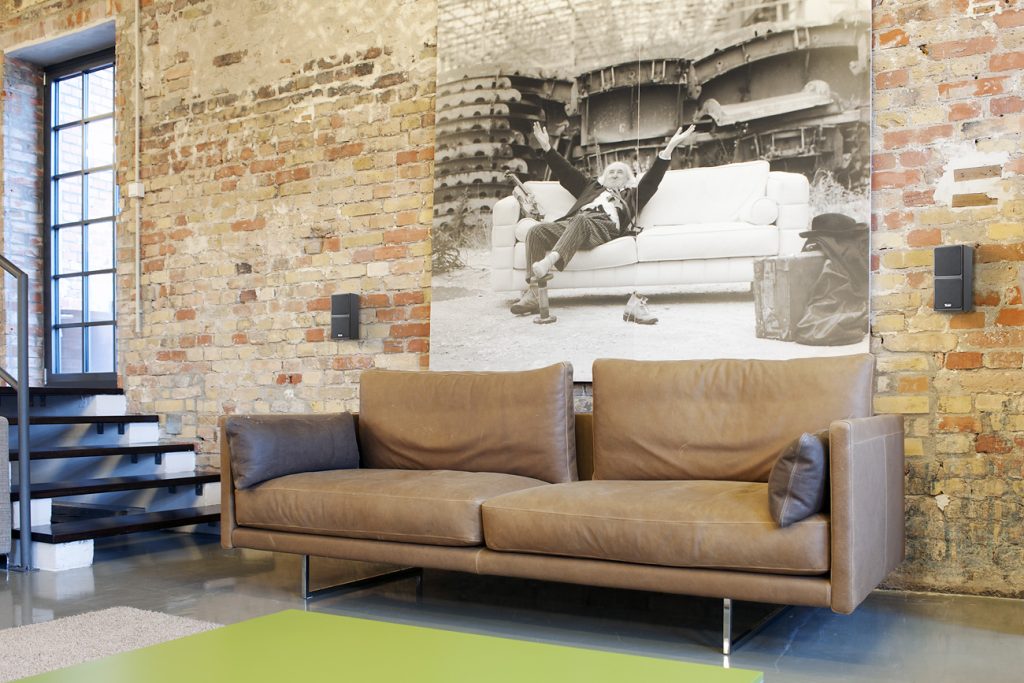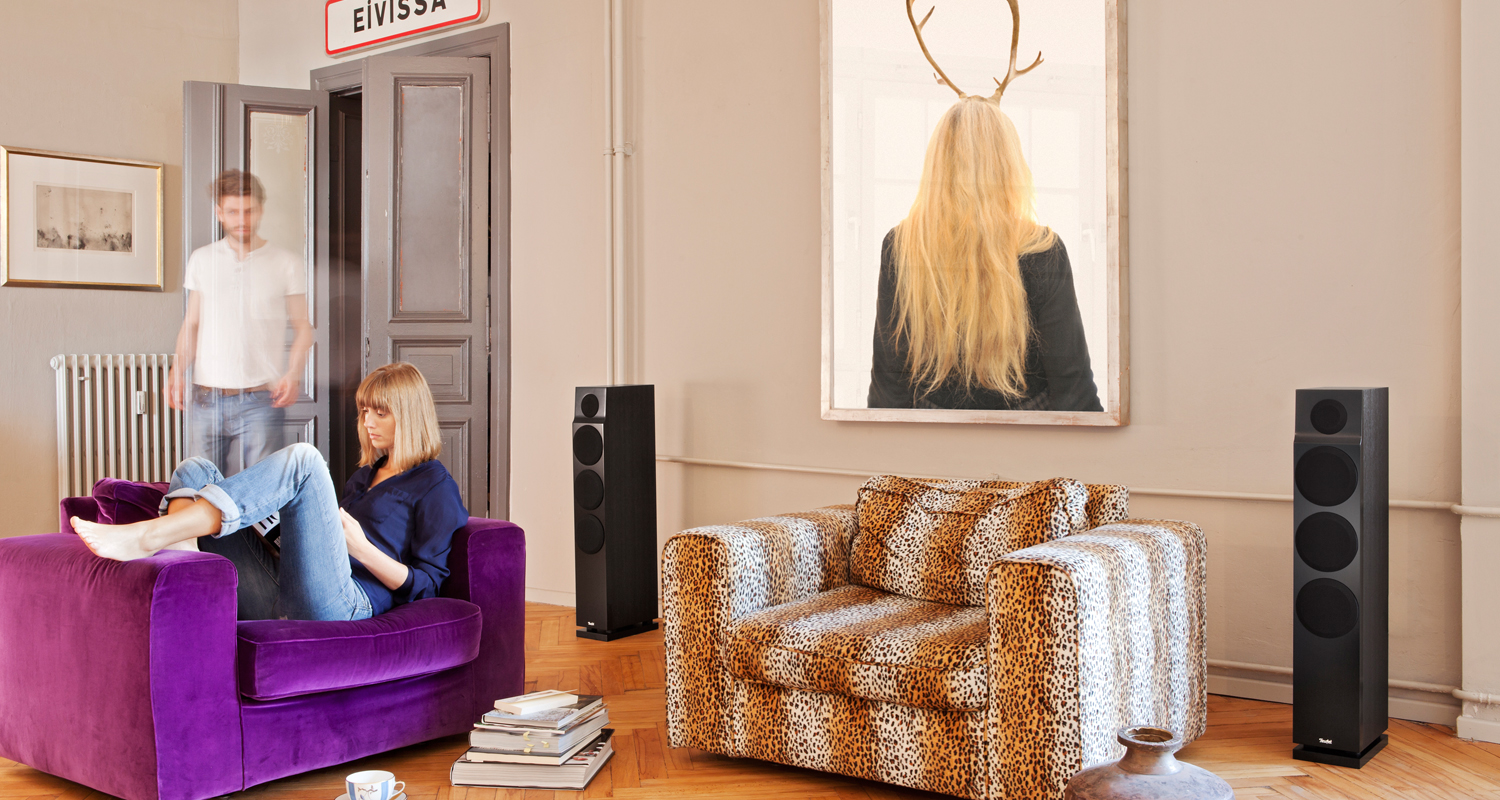The sound coming from your high-end system isn’t as good as it should be? The reason might have nothing to do with the speakers or the source material and everything to do with the relative positioning of the speakers to the listener. That’s because sound from multiple speakers meets and blends into an ideal sound image within a certain space. Outside of this area, the treble might be a little lacking, speech intelligibility a bit off, sound effects not quite localizable. Acousticians and audiophiles call the area in which the sound from all speakers is perfectly blended the sweet spot. The position of a sweet depends on the type of loudspeakers used and where they are placed relative to the listener.
But why do the relative positions of the individual speakers to each other have such a powerful effect on the overall sound? Does it really matter if one front speaker is closer to the listener than the other? Unfortunately, it does. To understand why requires a basic understanding of how sound travels through space. Sound is a series of pressure waves that move through the air, finally arriving at your ear. A particular sound produced by various speakers in a surround sound system can arrive at your ear at different times if the distance between these speakers and your ear is not the same. This is detrimental to the overall experience of the sound. Individual effects will be less clearly identifiable within the system’s soundstage and less distinct. It is therefore recommended that all speakers with a parallel function, such as the front and rear speakers, be located at equidistance from the listener. This will allow the sound to reach the listener’s two ears at the same time. In addition, the two front speakers should be placed at ear height (as judged from a seated position) and slightly angled into towards the listener.

The classic stereo triangle
A listener will experience the best sound from a pair of stereo speakers if the distance between each speaker to each other and to the listener is the same, essentially forming an equilateral triangle between the two speakers and the listener. The sweet spot in this case will be where the listener sits at the tip of the triangle. For an optimal sweet spot, the speakers should be placed at 60 degree angles to each other. The distance between the listening position and the area midway between the stereo speakers can be calculated using a conversion factor of .87. The following is a sample calculation:
Distance between two loudspeakers: 3.20 meters
3.20 x .87 = 2.78
The distance between the sweet spot (the tip of the triangle) and the midpoint between the two stereo speakers is 2.78 m
The stereo triangle, should not be seen as a hard and fast rule, but rather an aid to creating an optimal listening experience. One must always bear in mind that other factors such as room acoustics will affect the actual sound. However, it is recommended that any adjustments made to take real world conditions into account not deviate from an equilateral triangle by more than 20 percent. As a rule, the size of the room in which the speakers are placed will affect the size of the stereo triangle. With smaller distances, the triangle will be smaller and the sound will seem more intimate but usually at the cost of a more spacious soundstage which requires a bit of distance in order to unfold.
Achieving the right balance with 5.1 and 7.1 surround systems
As one might imagine, creating the perfect sweet spot becomes more challenging when more speakers are used. The good news is that even 5.1 and 7.1 surround sound systems use the tried-and-true stereo triangle as a guide for placing the two front speakers in relation to the listener. Additional loudspeakers are then arranged around the foundational triangle. The television should be placed between the two front speakers and slightly back from the imaginary line that connects them.
The center speaker – so important for rendering clear dialogue – should be centered beneath or above the television, ideally at the same height as the two front speakers. The subwoofer can be placed just about anywhere without affecting the overall sound. This is due to the fact that the human ear is not good at localizing very low frequencies. One basic rule to be observed is that the subwoofer should not be placed directly behind an obstacle or in a corner and that a position somewhere near the center speaker is fairly ideal.
The rear speakers in a 5.1 system should be placed approximately at the same height as the listener to either side, or slightly behind him or her. The distance from each speaker to the listener should be the same. The ideal height at which the rear speakers should be placed depends on the type of speaker and the room acoustics. The same applies to the two additional satellites in a 7.1 systems. As a rule, it’s important that these satellites are positioned at equidistance to the listener either to the side or slightly behind him or her.
Room correction technology for perfect room calibration
With so many variables, it can be difficult to arrive at an ideal positioning for a surround sound system. Front speakers and centers are often not placed along the same line and room interiors often don’t allow for sufficient distance between the sitting area and the rear speakers. High-end A/V receivers offer countless settings to compensate for these deficiencies.
Software like Audyssey, included in many A/V receivers can greatly assist in the precise calibration of surround sound systems. These programs use microphones to evaluate test signals produced by the speakers. The calibration should usually take multiple sitting positions into consideration in order to generate comprehensive data regarding room acoustics. The software then calibrates the speakers based on the results of the test. Afterwards, it’s always possible to adjust the system manually to account for personal taste.
[product id=”26076,26077,25941″]
Coda: It pays to take the time to test, experiment and calibrate
A listening experience is the sum total of a person’s physical ability to perceive sound, taste in music and movies (i.e., action films or dialogue-heavy films), quality of the speakers and the physical conditions of the room where the system is located. Yet, in most cases, it’s possible to optimize the sound of a stereo or surround sound system by using the basic proportions of a stereo triangle. Important here is that the two front speakers are at equidistance to the listener and radiate sound at ear height. The additional satellites in a 5.1 and 7.1 home cinema system should also be positioned as symmetrically as possible. Room correction technology integrated into most modern A/V receivers such as that offered by Audyssey can take the guesswork out of setting up your surround system so that you get the most out of your speakers.
All Other Pictures: Property of Teufel Audio






Leave a Reply